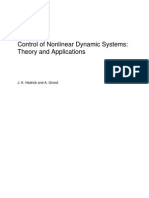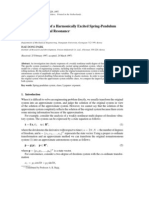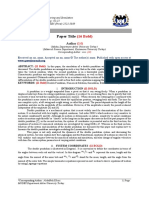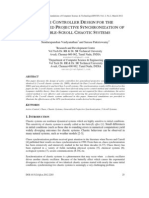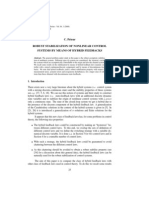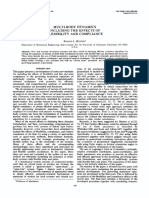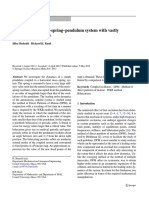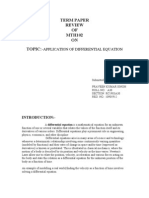Synchronization, Anti-Synchronization and Hybrid-Synchronization of A Double Pendulum Under The Effect of External Forces
Synchronization, Anti-Synchronization and Hybrid-Synchronization of A Double Pendulum Under The Effect of External Forces
Copyright:
Available Formats
Synchronization, Anti-Synchronization and Hybrid-Synchronization of A Double Pendulum Under The Effect of External Forces
Synchronization, Anti-Synchronization and Hybrid-Synchronization of A Double Pendulum Under The Effect of External Forces
Original Title
Copyright
Available Formats
Share this document
Did you find this document useful?
Is this content inappropriate?
Copyright:
Available Formats
Synchronization, Anti-Synchronization and Hybrid-Synchronization of A Double Pendulum Under The Effect of External Forces
Synchronization, Anti-Synchronization and Hybrid-Synchronization of A Double Pendulum Under The Effect of External Forces
Copyright:
Available Formats
I nternational Journal Of Computational Engineering Research (ijceronline.com) Vol. 3 Issue.
Synchronization, Anti-Synchronization and Hybrid-Synchronization Of A Double Pendulum Under The Effect Of External Forces
Ayub Khan1, Priyamvada Tripathi,2
1.
Depart ment Of Mathematics, Zakir Husain Delhi Co llege, Un iversity Of Delhi, Delh i110002, India 2. Depart ment Of Mathematics, University Of Delh i, Delhi110007, India;
Abstract
In the present manuscript, an investigation on synchronization, anti -synchronization and hybridsynchronization behavior of a double pendulum under the effect of external fo rces using active control technique based on the Lyapunov stability theory and the Routh-Hurwit z criteria, have been made. The designed controller with a new choice of co-efficient matrix of the error-dynamics are found to be effective in the stabilizat ion of error states at the origin, thereby achieving synchronization between the states variables of two dynamical systems under consideration. Nu merical simu lations have been presented to illustrate the effectiveness of the proposed control techniques using mathematica.
Keywords: Double Pendulum under the effect of external forces, Lyapunov stability theory and Routh - Hurwitz
Criteria, Synchronizat ion, Anti-synchronization and Hybrid- synchronization.
1 Introduction
Classically, synchronization means adjustment of rhythm of self-sustained periodic oscillations due to their weak interaction and this adjustment can be described in terms of phase -locking and frequency entrainment. In the modern context we call such type of objects as rotators and chaotic systems. The history of synchronization actually goes back to the 17th century. In 1673, when the famous Dutch scientist Huygens [1] observed weak synchronization of two double pendulum clocks, which is about two model shape of vibration. He had invented shortly before: It is quite worth noting that when we suspended two clocks so constructed from two hooks imbedded in the same wooden beam, the motion of each pendulum in opposite swings were so much in agreement and sound of each was always heard simu ltaneously. Furthermore he described that if one of the pendulum was disturbed by interference, it would return back to its normal state. This was first discovery of synchronization. After careful observation, finally he found that the cause of this is due to motion of the beam, even though this is hardly perceptible [2].Synchronization of periodic selfsustained oscillators are based on the existence of a special variable, called phase. If the coupled two pendulums have small oscillations with the same initial conditions or the zero initial phase difference, the two pendulums will be synchronized. If the in itial phase difference is 180, the anti-synchronization of two pendulums can be observed. For a general case, the motion of the two pendulums will be combined by the synchronization and anti-synchronization modes of vibration.The recent progress on the Huygens synchronization was presented in [3]. Chaotic synchronization did not attract much attention until Pecora and Carroll [4] introduced a method to synchronize two identical chaotic systems with different init ial conditions in 1990. Fro m then on, enormous studies have been done by researchers on the synchronization of dynamical systems. In 1994, Kap itaniak [5] used continuous control to achieve a synchronization of two chaotic systems. In 1996, Peng et al.[6] presented chaotic synchronization of n-dimensional system. In the past few decades, the concept of synchronization fro m the traditional point of view has also been extended. In 2002, Boccaletti et al. [7] gave a review on the synchronization of chaotic systems and clarified definit ions and concepts of dynamical system synchronization. In 2004, Co mpos and Urias [8] mathematically described multimodel synchronization with chaos, and introduced a multi -valued synchronized function. In 2005, Chen [9] investigated the synchronization of two different chaotic systems. Such synchronization is based on the error dynamics of the slave and master systems. The active control functions were used to remove non -linear terms, and the Lyapunov function was used to determine the stability of the synchronization. Lu and Cao [10] used the similar technique of Chen [9] to discuss the adaptive complete synchronization of two identical or different chaotic systems with unknown parameters. Thus in the continuation, a wide variety of methods have successfully been applied to achieve synchronization of chaotic systems. These methods including adaptive control [11, 12], backstepping design [13, 14, 15], active control [16, 17, 18] nonlinear control [19, 20, 21, 22] and observer based control method [23, 24]. Using these methods, numerous synchronization problem of well-known chaotic systems such as Lorenz, Chen, Lu and Rossler system have been worked on by many researchers. Recently, Ge et al. [25, 26, 27, 28, 29, 30] also studied
||Issn 2250-3005(online)|| ||January || 2013 Page 166
I nternational Journal Of Computational Engineering Research (ijceronline.com) Vol. 3 Issue. 1
chaotic synchronization of many practical physical systems and obtained interesting results. Among these methods, chaos synchronization using active control has recently been widely accepted because it can be used to synchronize identical as well as non-identical systems. In order to achieve stable synchronization this method has been applied to many practical systems such as the electronic circuits, in which model there is third order Jerk equation [31], Lore n z, Chen and Lu system [32], geophysical systems [33], nonlinear equations waves (Lorenz Stenflo system)[34], Van -der Pol-duffing oscillator [35], forced damped pendulum [36], RCL-shunted Josephson function [37], modified project ive synchronization [38]. In this paper, we have applied the active control techniques based on Lyapunov stability theory and Routh-Hurwit z criteria to study the synchronization, anti-synchronization and hybrid synchronization behavior of a double pendulum under the effect of external forces. It is well known that double pendulum is a chaotic system, its long term behavior can not be predicted. Slight changes in the initial conditions can result in drastic long term differences. If one starts the system at slightly different angles, perhaps by fraction of a degree, the resulting motion will not look same in the long run. In synchronization, two systems (master and slave) are synchronized and start with different initial conditions. The problem may be treated as the design of control laws for full chaotic slave system using known informat ion of the master system so as to ensure that the controlled receiver synchronizes with the master system. Hence, the slave chaotic system completely traces the dynamics of the master system in the course of time. The aim of this study is to investigate the synchronization, anti-synchronization and hybrid synchronization of a double pendulum under the effect of external forces.
2 Equations of Motion Of Double Pendulum Under The Effect Of External Forces
In the figure given below, a double pendulum consists of two point masses m1 and m2 connected by massless rods to the pivot point. Let 1 and 2 are the lengths of rods respectively and 1 and 2 be the angles that two rods make with the vertical. Let F be the external force exerted on the pivot point by pendulum and be the angle that F makes with rod 1.
Fig. 1
||Issn 2250-3005(online)||
||January || 2013
Page 167
I nternational Journal Of Computational Engineering Research (ijceronline.com) Vol. 3 Issue. 1
3 Synchronization Via Active Control
The systems defined by (1) and (2) can be written as a system of four first order differential equat ions, the four variables are introduced as below:
After expanding trigonometrical terms and neglecting higher order terms only (for reducing non -linearity) in the above equations, we get:
where ui(t), i = 1, 2, 3, 4 are control functions to be determined. Now defining error functions such that in synchronization state lim ei(t) 0, i = 1, 2, 3, 4. t e1 = y1 - x1 e2 = y2 - x2 e3 = y3 - x3 e4 = y4 - x4 and the error dynamics are expressed as:
||Issn 2250-3005(online)||
||January || 2013
Page 168
I nternational Journal Of Computational Engineering Research (ijceronline.com) Vol. 3 Issue. 1
The error dynamical system (7) to be controlled must be a linear system with control inputs. Therefore we redefine the control functions such as to eliminate non-linear terms in e1(t), e2(t), e3(t) and e4(t) of equation (7) as follows:
using (7) and (8), we have
where B is 44 co-efficient matrix. According to the Lyapunov stability theory and Routh-Hurwit z criteria, eigenvalues of the co-efficient matrix of error system must be real or co mp lex with negative real parts. We can choose elements of matrix arbit rarily; there are several ways to choose in order to satisfy Lyapunov and Routh -Herwit z criteria. Consequently, for
||Issn 2250-3005(online)|| ||January || 2013 Page 169
I nternational Journal Of Computational Engineering Research (ijceronline.com) Vol. 3 Issue. 1
(11)
becomes a matrix with eigen values having negative real parts and equation (10) reduces to
(12)
Thus, by Lyapunov stability theory, the error dynamical system (12) is stable. 4 . Numerical Si mulation For Synchronization For the parameters involved in system under investigation, T1 = 1, T2 = 2, 1 = 1, 2 = 2, m1 = 1,m2 = 1 and g = 9.8m/s2 with the init ial conditions for master system and slave system [x1(0), x2(0), x3(0), x4(0)] = [3.5, 0.4,- 3.5, 0.4] And [y1(0), y2(0), y3(0), y4(0)] = [1.5, 0.2,- 0.5, 0.8] respectively. We have simulated the system under consideration using mathemat ica. Phase portraits and time series analysis of master and slave system are the witness of irregular behavior of system (see figures 2, 3, 4 and 5). For [e1(0), e2(0), e3(0), e4(0)] = [- 2, 0.2, 3, 0.4] convergence diagrams of errors are the witness of achieving synchronization between master and slave systems (see figure 6).
5 Anti-Synchronization Via Active Control
In order to formu late the active controllers fo r anti-synchronization we need to redefine the erro r functions as, e1 (t) = y1 + x1, e2 (t) = y2 + x2, e3 (t) = y3 + x3, e4 (t) = y4 + x4. Accordingly, error dynamics are:
||Issn 2250-3005(online)||
||January || 2013
Page 170
I nternational Journal Of Computational Engineering Research (ijceronline.com) Vol. 3 Issue. 1
In order to express (13) as only linear terms in e1(t ), e2(t), e2(t) and e4(t), we redefine the control functions as follows:
Furthermore, as in the previous case we choose v1(t), v2(t), v3(t) and v4(t) as fo llo ws:
where B is given by (11) whose eigen values have negative real parts. Thus by Lyapunov stability theory, the error dynamical system (15) is stable.
||Issn 2250-3005(online)|| ||January || 2013 Page 171
I nternational Journal Of Computational Engineering Research (ijceronline.com) Vol. 3 Issue. 1
6 Numerical Simulation For Anti-Synchronization
For the parameters involved in system under investigation, T1 = 1, T2 = 2, 1 = 1, 2 = 2, m1 = 1, m2 = 1 and g = 9.8m/s2 with the in itial conditions for master and slave systems [x1(0), x2(0), x3(0), x4(0)] = [3.5, 0.4,-3.5, 0.4] and [y1(0), y2(t), y3(0), y4(0)] = [1.5, 0.2,-0.5, 0.8] respectively. We have simulated the system under consideration using mathematica. Phase portraits and time series analysis of master system and slave system are the witness of irregular behavior of system (see figures 2, 3, 4 and 5). For [e1(0), e2(0), e3(0), e4(0)] = [5, 0.6,4.0, 1.2] convergence diagram of errors are the witness of achieving anti-synchronization between master and slave system (see figure 7).
7 Hybrid Synchronization Via Active Control
The idea of the hybrid synchronization is to use the output of the master system to control the slave system so that the odd outputs of the two systems are completely synchronized, wh ile the even outputs of the two systems are anti-synchronized so that both complete synchronization and anti-synchronization persist in the synchronization of master and slave systems. In order to formulate the active controllers for hybrid synchronization we are redefining the error functions in the following three ways:
||Issn 2250-3005(online)||
||January || 2013
Page 172
I nternational Journal Of Computational Engineering Research (ijceronline.com) Vol. 3 Issue. 1
The error dynamical system (16) to be controlled must be a linear system with control inputs. Therefore we redefine the control functions such as to eliminate non-linear terms in e1(t), e2(t), e3(t) and e4(t) of (16) as follows:
and (18) reduces to
where B is given by (11), whose eigen-values have negative real parts. Thus, by Lyapunov stability theory, the error dynamical system (18) is stable.
Page 173
||Issn 2250-3005(online)||
||January || 2013
I nternational Journal Of Computational Engineering Research (ijceronline.com) Vol. 3 Issue. 1
8 Numerical Simulation For Hybrid Synchronization
For the parameters involved in system under investigation, T1 = 1, T2 = 2, 1 = 1, 2 = 2, m1 = 1, m2 = 1 and g = 9.8m/s2 with the init ial conditions of master and slave systems [x1(0), x2(0), x3(0), x4(0)] = [3.5, 0.4,-3.5, 0.4], and [y1(0), y2(0), y3(0), y4(0)] = [1.5, 0.2,-0.5, 0.8] respectively. We have simulated the system under consideration by using mathemat ica. Phase portraits and time series analysis of master and slave system are the witness of irregulars behavior of the system (see figures 2, 3, 4 and 5) and fo r [e1(0), e2(0), e3(0), e4(0)] = [-2, 0.6, 3, 1.2] convergence diagram of errors are the witness of achieving hybrid synchronization between master and slave system (see figure 8). Figures are given below:
||Issn 2250-3005(online)||
||January || 2013
Page 174
I nternational Journal Of Computational Engineering Research (ijceronline.com) Vol. 3 Issue. 1
9 Conclusion
An investigation on synchronization, anti-synchronization and hybrid synchronization of the double pendulum under the effect of external forces via active control technique based on Lyapunov stability theory and Routh -Hurwitz criteria have been made. The results are validated by numerical simu lations using mathemat ica.
References
[1] [2] [3] [4] [5] [6] [7] [8] [9] [10] [11] [12] [13] [14] [15] Huygens (Hugenii) (1986), Horologiu m Oscillatoriu m, Apud F. Muguet, Parisiis, France, 1973 (English translation: The pendulum clock, Lowa State University, A mes, 1986). A. Pikovsky, M. Rosenblum and J. Kurths. Synchronization, Cambridge Nonlinear Science Series, 12, Cambridge Un iv. Press, Cambridge, 2001. G. Leonov, H. Nijmeijer, A. Pogro msky and A. Fradkov, Dynamics and Control of Hybrid Mechanical Systems, World Scientific, Singapore, 2010. L. M. Pecora and T. L. Carro ll. Synchronization in Chaotic Systems. Phys. Rev. Lett. 64 (1990), no. 8, 821 824. T. Kapitaniak. Synchronization of Chaos Using Continuous Control, Physical Review E 50 (1994), Issue 2, 1642-1644. J. H. Peng, E. J. Ding, M. Ding and W. Yang. Synchronizing Hyperchaos with a Scalar Transmitted Signal, Physical Rev iew Letters 76 (1996) 904-907. S. Boccaletti, J. Kurths, G. Osipov, D. L. Valladares and C. S. Zhou. The Synchronization of Chaotic Systems. Phys. Rep. 366 (2002), no. 1-2, 1 101. E. Campos, J. Uras and N. F. Ru lkov. Mult imodal Synchronization of Chaos, Chaos 14 (2004), no. 1, 48 54. H. K. Chen. Synchronizat ion of Two Different Chaotic Systems: A New System and Each of the Dynamical Systems Loren z, Chen and Lu, Chaos Solitons Fractals 25 (2005), no. 5, 10491056. J. Lu and J. Cao. Adaptive Co mplete Synchronization of Two Identical or Different Chaotic (Hyperchaotic) Systems with Fu lly Unknown Parameters, Chaos 15 (2005), no. 4, 043901, 10 pp. S. H. Chen and J. Lu. Synchronization of an Uncertain Un ified System via Adaptive Control, Chaos Solitons & Fractals 14(2002), 643647. Z. M. Ge and Y. S. Chen. Adaptive Synchronization of Unidirectional and Mutual Coupled Chaotic Systems, Chaos Solitons & Fractals 26(2005), 881888. C. Wang and S.S. Ge. Synchronization of Two Uncertain Chaotic Systems via Adaptive Backstepping, Int. J. Bifurcat. Chaos 11(2001), 1743- 1751. C. Wang and S. S. Ge. Adaptive Synchronizat ion of Uncertain Chaotic Systems via Adaptive Backstepping Design, Chaos Solitons & Fractals 12(2001), 11991206. X. Tan, J. Zhang and Y. Yang. Synchronizing Chaotic Systems Using Backstepping Design, Chaos Solitons & Fractals 16(2003): 3745.
||January || 2013 Page 175
||Issn 2250-3005(online)||
I nternational Journal Of Computational Engineering Research (ijceronline.com) Vol. 3 Issue. 1
[16] [17] [18] [19] [20] [21] [22] [23] [24] [25] [26] [27] [28] [29] [30] [31] [32] [33] [34] [35]
[36] [37] [38] [39]
H. K. Chen. Synchronizat ion of Two Different Chaotic System: A New System and Each of the Dynamical Systems Loren z, Chen and Lu, Chaos Solitons & Fractals 25(2005), 10491056. M. C. Ho and Y.C. Hung. Synchronization two Different Systems by using Generalized Active Control, Phys. Lett. A 301(2002), 424 428. M. T. Yassen. Chaos Synchronization Between Two Different Chaotic Systems using Active Control, Chaos Solitons & Fractals 23(2005), 131140. J. H. Park. Chaos Synchronization Between Two Different Chaotic Dynamical Systems, Chaos Solitons & Fractals 27(2006), 549554. L. Huang, R. Feng and M. Wang. Synchronization of Chaotic Dynamical Systems via Nonlinear Control, Phys. Lett. A 320(2004), 271 275. H. K. Chen. Global Chaos Synchronization of New Chaotic Systems via Nonlinear Control, Chaos Solitons & Fractals 23(2005), 12451251. J. H. Park. Chaos Synchronization of a Chaotic System v ia Nonlinear Control, Chaos Solitons & Fractals 25(2005), 549584. Z. M. Ge, T.C. Yu and Y.S. Chen. Chaos Synchronization of a Horizontal Platfo rm System, J. Sound Vibrat 268(2003), 731 749. Gl. Wen and D. Xu. Observer-based Control for Full-state Projective Synchronization of a General Class of Chaotic Maps in Any Dimension, Phys. Lett. A 330(2004), 420425. Gl. Wen and D. Xu, Nonlinear Observer Control for Full-state Projective Synchronization in Chaotic Continuous-time Systems, Chaos Solitons & Fractals 26(2005), 7177. Z. M. Ge, J.W. Cheng and Y.S. Chen. Chaos Anti-control and Synchronization of Three Time Scales Brushless DC Motor System, Chaos Solitons & Fractals 22(2004), 11651182. Z. M. Ge and H.W. Wu. Chaos Synchronization and Chaos Anti-control of a Suspended Track with Moving Load, J. Sound Vibrat 270(2004), 685712. Z. M. Ge and C. C. Chen. Phase Synchronization of Coupled Chaotic Multiple Time Scale Systems, Chaos Solitons & Fractals 20(2004), 639647. Z. M. Ge and C.I. Control, Anti-control and Synchronization of Chaos for an Autonomous Rotational -mach ine System with Time-delay, Chaos Solitons & Fractals 23(2005), 18551864. Z. M. Ge, C.M. Chang and Y.S. Chen. Anti-control of Chaos of Single Time Scale Brushless DC Motors and Chaos Synchronization of Different Order Systems, Chaos Solitons & Fractals 27(2006), 1298-1315. E. W. Bai and K. E. Lonngren. Synchronization of Two Lorenz Systems Using Active Control, Chaos, Soliton & Fractials 9 (1998), 1555-1561. H. K. Chen. Synchronizat ion of Two Different Chaotic Systems: A New System and Each of the Dynamica l Systems Loren z, Chen and Lu, Chaos Solitons Fractals 25 (2005), no. 5, 10491056. U. E. Vincent. Synchronization of Rikitake Chaotic Attractor using Active Control, Physics Letter, Sect ion A, 343 (1-3) (2005), 133138. U. E. Vincent. Synchronization of Identical and Non-identical 4-D Chaotic Systems Using Active Control, Chaos Solitons Fractals 37 (2008), no. 4, 10651075. A. N. Njah and U. E. Vincent. Synchronization and Anti-synchronization of Chaos in an Extended Bonhoffer-Van Der Pol Oscillator Using Active Control, Journal of Sound and Vibration 319(1-2) (2009), 41 49. A. Ucar, K. E. Lonngren, and E. W. Bai. Synchronizat ion of Chaotic Behavior in Nonlinear Bloch Equations, Phys. Lett. A 314 (2003), no. 1-2, 96101. A. Ucar, K. E. Lonngren and E.W. Bai. Chaos Synchronization in RCL-Shunted Josephson Junction via Active Control, Chaos, Solitons & Fractals 31 (1) (2007), 105111. H. Zhu and X. Zhang. Modified Projective Synchronizat ion of Different Hyprchaotic Systems, Journal of Information and Co mputing Science 4 (2009), 33 40. Ch ris LeBailly. Synchronization of Chaotic Oscillators, Evanston Township High-School, November 19, 2003.
||Issn 2250-3005(online)||
||January || 2013
Page 176
You might also like
- Nonlinear Model & Controller Design For Magnetic Levitation System-IsPRADocument5 pagesNonlinear Model & Controller Design For Magnetic Levitation System-IsPRAIshtiaq AhmadNo ratings yet
- Control of Nonlinear Dynamic SystemsDocument250 pagesControl of Nonlinear Dynamic SystemsFilipe Alemão100% (1)
- Chaotic Dynamics of A Harmonically Excited Spring-Pendulum System With Internal ResonanceDocument19 pagesChaotic Dynamics of A Harmonically Excited Spring-Pendulum System With Internal Resonancechandan_j4uNo ratings yet
- Linear Dynamical System KalmanDocument41 pagesLinear Dynamical System KalmanNitin BhitreNo ratings yet
- Case Studies On Nonlinear Control Theory of The Inverted PendulumDocument28 pagesCase Studies On Nonlinear Control Theory of The Inverted PendulumDragan ErcegNo ratings yet
- Investigation of Modal Interactions and Their Effec - 2017 - International JournDocument12 pagesInvestigation of Modal Interactions and Their Effec - 2017 - International JournJuan José MartinezNo ratings yet
- Composite Robust Control of A Laboratory Flexible ManipulatorDocument6 pagesComposite Robust Control of A Laboratory Flexible ManipulatorinfodotzNo ratings yet
- Volume 18 Issue 14 December 2012Document15 pagesVolume 18 Issue 14 December 2012Thien MaiNo ratings yet
- Stochastic Stability PropertiesDocument16 pagesStochastic Stability PropertiesJosiane FerreiraNo ratings yet
- Non-Linear Analysis of Vibrations of Non-Linear System Subjected To Multi-Excitation Forces Via A Non-Linear AbsorberDocument9 pagesNon-Linear Analysis of Vibrations of Non-Linear System Subjected To Multi-Excitation Forces Via A Non-Linear AbsorberMac RodgeNo ratings yet
- Article AMB First PNGDocument31 pagesArticle AMB First PNGFABIEN KENMOGNENo ratings yet
- 0304023v1 PDFDocument69 pages0304023v1 PDFBayer MitrovicNo ratings yet
- Single Mode Control and Chaos of Cantilever Beam Under Primary and Principal Parametric Excitations 2006 Chaos Solitons FractalsDocument24 pagesSingle Mode Control and Chaos of Cantilever Beam Under Primary and Principal Parametric Excitations 2006 Chaos Solitons FractalsDhirendra Kumar PandeyNo ratings yet
- Synchronization of Chaotic Systems With Uncertain Parameters by Adaptive ControlDocument4 pagesSynchronization of Chaotic Systems With Uncertain Parameters by Adaptive Controllaz_chikhi1574No ratings yet
- Nonlinear Dynamic Analysis of Planar Flexible Unde - 2005 - Chinese Journal of ADocument5 pagesNonlinear Dynamic Analysis of Planar Flexible Unde - 2005 - Chinese Journal of ApachterNo ratings yet
- Author Guidelines QuestDocument14 pagesAuthor Guidelines QuestpcmsathishkumarNo ratings yet
- The Particle Swarm - Explosion, Stability, and Convergence in A Multidimensional Complex Space PDFDocument16 pagesThe Particle Swarm - Explosion, Stability, and Convergence in A Multidimensional Complex Space PDFAzad HannanNo ratings yet
- Active Controller Design For The Generalized Projective Synchronization of Double-Scroll Chaotic SystemsDocument17 pagesActive Controller Design For The Generalized Projective Synchronization of Double-Scroll Chaotic SystemsijfcstjournalNo ratings yet
- Synchronized States in Chaotic Systems Coupled Indirectly Through Dynamic EnvironmentDocument8 pagesSynchronized States in Chaotic Systems Coupled Indirectly Through Dynamic Environmentalpha_numericNo ratings yet
- C. Prieur Robust Stabilization of Nonlinear Control Systems by Means of Hybrid FeedbacksDocument14 pagesC. Prieur Robust Stabilization of Nonlinear Control Systems by Means of Hybrid Feedbackssouvik5000No ratings yet
- Circadian Phase Control Using Observer-Based Back-Stepping DesignDocument6 pagesCircadian Phase Control Using Observer-Based Back-Stepping DesignSähilDhånkhårNo ratings yet
- Differential Equations Solving The Oscillation SysDocument7 pagesDifferential Equations Solving The Oscillation SysBrijesh MishraNo ratings yet
- Approximate Controllability of Second-Order Evolution Differential Inclusions in Hilbert SpacesDocument22 pagesApproximate Controllability of Second-Order Evolution Differential Inclusions in Hilbert Spacesbalraj dNo ratings yet
- 381-Multi-Body Dynamics Including The Effects of Flexibility and ComplianceDocument9 pages381-Multi-Body Dynamics Including The Effects of Flexibility and CompliancejinshuaixuNo ratings yet
- Control System Engineering Lecturer NoteDocument66 pagesControl System Engineering Lecturer NoteTawose Ayomide IsraelNo ratings yet
- A Dynamic Study of A Bead Sliding On A Wire in Fractal Space With The Non-Perturbative TechniqueDocument18 pagesA Dynamic Study of A Bead Sliding On A Wire in Fractal Space With The Non-Perturbative Techniquenasser522000No ratings yet
- Dynamics of The Non-Ideal Mechanical Systems A ReviewDocument12 pagesDynamics of The Non-Ideal Mechanical Systems A ReviewChristian MavarezNo ratings yet
- Mass Pendulum SpringDocument17 pagesMass Pendulum SpringPaola DelenaNo ratings yet
- ArticleDocument9 pagesArticleKrzysztof WitkowskiNo ratings yet
- SOS MetricsDocument8 pagesSOS Metricsmenilanjan89nLNo ratings yet
- On Null Controllability of Nonlinear Neutral-Type Fractional-Order Differential Systems With State Delays and Distributed Delays in The Control, and Impulsive EffectsDocument16 pagesOn Null Controllability of Nonlinear Neutral-Type Fractional-Order Differential Systems With State Delays and Distributed Delays in The Control, and Impulsive EffectsInternational Journal of Innovative Science and Research TechnologyNo ratings yet
- Homogeneous Feedback Control of Nonlinear Systems Based On Control Lyapunov FunctionsDocument9 pagesHomogeneous Feedback Control of Nonlinear Systems Based On Control Lyapunov FunctionsNoorAhmedNo ratings yet
- Author GuidelinesDocument14 pagesAuthor GuidelinesYAMINIPRIYANNo ratings yet
- Murrell Carter HallonenDocument28 pagesMurrell Carter HallonenCu miNo ratings yet
- Adaptive Hybrid Chaos Synchronization of Lorenz-Stenflo and Qi 4-D Chaotic Systems With Unknown ParametersDocument20 pagesAdaptive Hybrid Chaos Synchronization of Lorenz-Stenflo and Qi 4-D Chaotic Systems With Unknown ParametersijfcstjournalNo ratings yet
- I Artykuł SageDocument13 pagesI Artykuł SageKrzysztof WitkowskiNo ratings yet
- Nonholonomic Control Systems On Riemannian Manifolds : L. IntroductionDocument21 pagesNonholonomic Control Systems On Riemannian Manifolds : L. IntroductionLuis Rios SantillanaNo ratings yet
- Stabilizability of Linear Switching SystDocument15 pagesStabilizability of Linear Switching Systandressamoura91No ratings yet
- Control Theory From The Geometric ViewpointDocument424 pagesControl Theory From The Geometric Viewpointspartano4991No ratings yet
- A NEW HYPERCHAOTIC SYSTEM WITH COEXISTING ATTRACTORS: ITS CONTROL, SYNCHRONIZATION AND SECURE COMMUNICATIONA new hyperchaotic system with coexisting attractors based on Sprott B chaotic system is proposed in this work. A novel feature of this new hyperchaotic system under investigation is that it has two-wing and fourwing coexisting attractors for two sets of different initial conditions. Thus, the new hyperchaotic system has hidden attractors. Interestingly, the proposed designed control function u (t) i using adaptive control method was able to control and globally synchronizes two identical new hyperchaotic systems evolving from different initial conditions with uncertain parameters. The adaptive synchronization scheme was applied to secure communication. Finally, the numerical simulation results presented demonstrated the effectiveness of the analytical results of the designed schemeDocument15 pagesA NEW HYPERCHAOTIC SYSTEM WITH COEXISTING ATTRACTORS: ITS CONTROL, SYNCHRONIZATION AND SECURE COMMUNICATIONA new hyperchaotic system with coexisting attractors based on Sprott B chaotic system is proposed in this work. A novel feature of this new hyperchaotic system under investigation is that it has two-wing and fourwing coexisting attractors for two sets of different initial conditions. Thus, the new hyperchaotic system has hidden attractors. Interestingly, the proposed designed control function u (t) i using adaptive control method was able to control and globally synchronizes two identical new hyperchaotic systems evolving from different initial conditions with uncertain parameters. The adaptive synchronization scheme was applied to secure communication. Finally, the numerical simulation results presented demonstrated the effectiveness of the analytical results of the designed schemehugoshan513No ratings yet
- Control of A Class of Pendulum-Like Systems With Lagrange StabilityDocument6 pagesControl of A Class of Pendulum-Like Systems With Lagrange StabilityLessia MonserratNo ratings yet
- 1 s2.0 S0997753820304393 MainDocument17 pages1 s2.0 S0997753820304393 MainDr-Nasser A. SaeedNo ratings yet
- Global Stochastic Synchronization of Chaotic OscillatorsDocument6 pagesGlobal Stochastic Synchronization of Chaotic OscillatorsBit32No ratings yet
- Bryan Eisenhower and Igor Mezic - Targeted Activation in Deterministic and Stochastic SystemsDocument10 pagesBryan Eisenhower and Igor Mezic - Targeted Activation in Deterministic and Stochastic SystemsYidel4313No ratings yet
- Vincentetal2005 MPLBDocument7 pagesVincentetal2005 MPLBlodrigaspeNo ratings yet
- Journal IEEE Usman PagalayDocument5 pagesJournal IEEE Usman PagalayMukhammaFahmiNo ratings yet
- Adaptive Control For A Class of Non-Affine Nonlinear Systems Via Neural NetworksDocument37 pagesAdaptive Control For A Class of Non-Affine Nonlinear Systems Via Neural Networkskj185No ratings yet
- Design of Stabilizing Switching Laws For Mixed Switched Affine SystemsDocument6 pagesDesign of Stabilizing Switching Laws For Mixed Switched Affine SystemsablaoublasNo ratings yet
- Modal Simulation and Experiment Analysis of CoriolDocument4 pagesModal Simulation and Experiment Analysis of Coriolmuhammed.eNo ratings yet
- Mth102 Differential EquationDocument3 pagesMth102 Differential EquationPraveen Kumar SinghNo ratings yet
- ClosechainDocument15 pagesClosechainQuyết Nguyễn CôngNo ratings yet
- Determination of Approximate Lumping Schemes by A Singular Perturbation MethodDocument13 pagesDetermination of Approximate Lumping Schemes by A Singular Perturbation Methodizaquiel22No ratings yet
- Control of Inverted Pendulum Cart System by Use of Pid ControllerDocument6 pagesControl of Inverted Pendulum Cart System by Use of Pid ControllerDr Saba TareqNo ratings yet
- PNAS 2013 Green 16339 43Document7 pagesPNAS 2013 Green 16339 43Ryan PavlickNo ratings yet
- Stability of Nonlinear SystemsDocument18 pagesStability of Nonlinear SystemssalimNo ratings yet
- 1264299Document8 pages1264299Stream stuffNo ratings yet
- On An Optimal Linear Control of A Chaotic Non-Ideal Duffing SystemDocument7 pagesOn An Optimal Linear Control of A Chaotic Non-Ideal Duffing SystemJefferson MartinezNo ratings yet
- A UNITARY THEORI OF NUCLEAR, ELECTROMAGNETIC AND GRAVITAIONAL FIELDSFrom EverandA UNITARY THEORI OF NUCLEAR, ELECTROMAGNETIC AND GRAVITAIONAL FIELDSNo ratings yet
- Parametric Study On Analysis and Design of Permanently Anchored Secant Pile Wall For Earthquake LoadingDocument16 pagesParametric Study On Analysis and Design of Permanently Anchored Secant Pile Wall For Earthquake LoadingInternational Journal of computational Engineering research (IJCER)No ratings yet
- A Real Time Abandoned Object Detection and Addressing Using IoTDocument5 pagesA Real Time Abandoned Object Detection and Addressing Using IoTInternational Journal of computational Engineering research (IJCER)No ratings yet
- Parametric Study On Analysis and Design of Permanently Anchored Secant Pile Wall For Earthquake LoadingDocument16 pagesParametric Study On Analysis and Design of Permanently Anchored Secant Pile Wall For Earthquake LoadingInternational Journal of computational Engineering research (IJCER)No ratings yet
- PCB Faults Detection Using Image ProcessingDocument5 pagesPCB Faults Detection Using Image ProcessingInternational Journal of computational Engineering research (IJCER)No ratings yet
- Relationship Between Refractive Index, Electronic Polarizavility, Optical Energy Gap Optical Electronegativity and Plasmon Energy in I-Iii-Vi2 and Ii-Iv-V2 Groups of Semi Conductors.Document5 pagesRelationship Between Refractive Index, Electronic Polarizavility, Optical Energy Gap Optical Electronegativity and Plasmon Energy in I-Iii-Vi2 and Ii-Iv-V2 Groups of Semi Conductors.International Journal of computational Engineering research (IJCER)No ratings yet
- Conceptual Design and Structural Analysis of Solid Rocket Motor CasingDocument6 pagesConceptual Design and Structural Analysis of Solid Rocket Motor CasingInternational Journal of computational Engineering research (IJCER)No ratings yet

